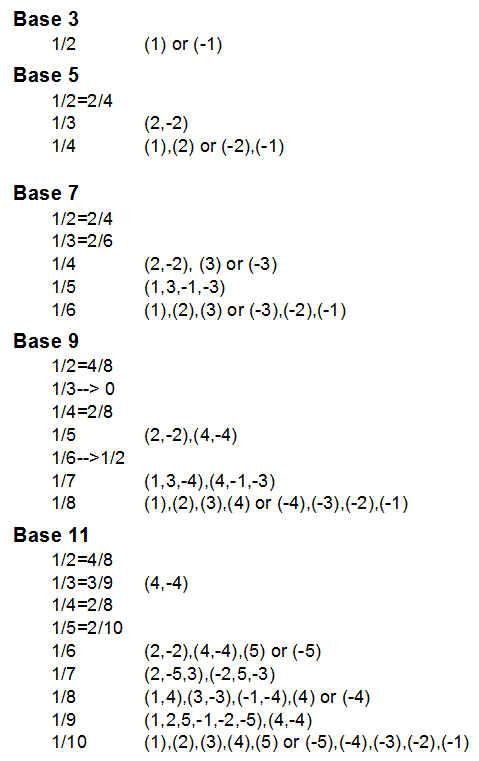Balanced Base N-Grams
For odd number bases using balanced digits (see Balanced Ternary), NGram-like patterns are going to be somewhat different. This is an area I’ve not given much attention. The image below has information on patterns of division in odd bases 3 to 11. The notation is terse, so I will explain.
For each base, I list the possible fractions of relevance. When a fraction is an instance of division by a larger number I give the equivalence (e.g., 1/2=2/4). If a pattern has no repetition [because of prime factors in common], it “zeroes out” e.g., 1/3–> 0). If it has only some prime factors in common, I show the related fraction that does have a pattern in this base (e.g., 1/6–>1/2).
The largest digit in these bases is (base-1)/2. The smallest is the negative of this value. Zero is therefore always the value in the middle of the sequence. As with the N-Grams discussed above, zero never occurs in the digit patterns except for 0/N, N/N, or fractions that “zero out”. In the N-Grams above, the largest digit never appears in digit patterns except as a stand-in for zero (in base ten, 0.999… = 1.000…). Here, something different occurs, because of the special role 1/2 plays in these patterns. In base 3, for instance, 1/2 = 1 -1/3 – 1/9 – 1/27 – … = 0 + 1/3 + 1/9 + 1/27+ … . It can be represented by either of 2 patterns, indicated below wherever you see an “or”.
Each pair of parentheses encloses a repeating pattern. Every row could include the pattern (0), but I’ve left it out. (1) represents 0.111… . (2,-2) indicates the fractional digits alternate between 2 and -2.
So far, there don’t seem to be the same sort of natural pairings that there were in the N-Grams for bases where zero is the smallest digit. For instance in base 9, 1/7 includes all the non-zero digits except for 2 and -2. But there is no other division that includes only those digits in its patterns. 1/4 = (2), 2/4=1/2 = (4) or (-4), 3/4 = (-2); 1/5 also uses these same digits (+/- 2 and 4) but in different sequences.


